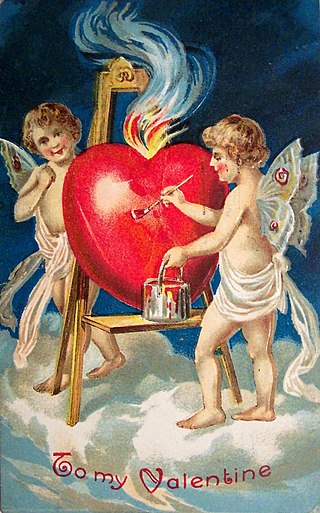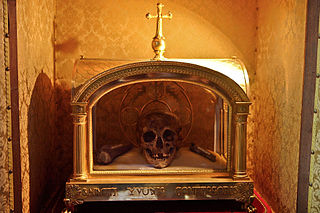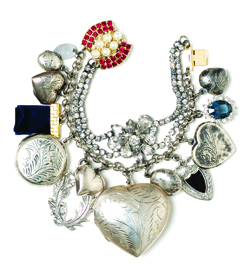Related Research Articles

Anthony of Padua, OFM or Anthony of Lisbon was a Portuguese Catholic priest and friar of the Franciscan Order.

Saint Valentine was a 3rd-century Roman saint, commemorated in Western Christianity on February 14 and in Eastern Orthodoxy on July 6. From the High Middle Ages, his Saints' Day has been associated with a tradition of courtly love. He is also a patron saint of Terni, epilepsy and beekeepers. Saint Valentine was a clergyman – either a priest or a bishop – in the Roman Empire who ministered to persecuted Christians. He was martyred and his body buried on the Via Flaminia on February 14, which has been observed as the Feast of Saint Valentine since at least the eighth century.

Valentine's Day, also called Saint Valentine's Day or the Feast of Saint Valentine, is celebrated annually on February 14. It originated as a Christian feast day honoring a martyr named Valentine and through later folk traditions, it has also become a significant cultural, religious and commercial celebration of romance and love in many regions of the world.

In religion, a relic is an object or article of religious significance from the past. It usually consists of the physical remains or personal effects of a saint or other person preserved for the purpose of veneration as a tangible memorial. Relics are an important aspect of some forms of Buddhism, Christianity, Islam, shamanism, and many other religions. Relic derives from the Latin reliquiae, meaning "remains", and a form of the Latin verb relinquere, to "leave behind, or abandon". A reliquary is a shrine that houses one or more religious relics.

A potion is a liquid "that contains medicine, poison, or something that is supposed to have magic powers." It derives from the Latin word potio which refers to a drink or the act of drinking. The term philtre is also used, often specifically for a love potion, a potion that is supposed to create feelings of love or attraction in the one who drinks it. Throughout history there have been several types of potions for a range of purposes. Reasons for taking potions ranged from curing an illness, to securing immortality to trying to induce love. These potions, while often ineffective or poisonous, occasionally had some degree of medicinal success depending on what they sought to fix and the type and amount of ingredients used. Some popular ingredients used in potions across history include Spanish fly, nightshade plants, cannabis, and opium.
The seventh son of a seventh son is a concept from folklore regarding special powers given to, or held by, such a son. To qualify as "the seventh son of a seventh son" one must be the seventh male child born in an unbroken line with no female siblings born between, and to a father who himself is the seventh male child born in an unbroken line with no female siblings born between. The number seven has a long history of mystical and biblical significance, such as seven virtues, seven deadly sins, Seven Sleepers and Seven Heavens.

The cimaruta is an Italian folk amulet or talisman, traditionally worn around the neck or hung above an infant's bed to ward off the evil eye. Commonly made of silver, the amulet itself consists of several small apotropaic charms, with each individual piece attached to what is supposed to represent a branch of rue—the flowering medicinal herb for which the whole talisman is named, "cimaruta" being a Neapolitan form of cima di ruta: Italian for "sprig of rue".

The heart symbol is an ideograph used to express the idea of the "heart" in its metaphorical or symbolic sense. Represented by an anatomically inaccurate shape, the heart symbol is often used to represent the center of emotion, including affection and love, especially romantic love. It is sometimes accompanied or superseded by the "wounded heart" symbol, depicted as a heart symbol pierced with an arrow or as a heart symbol "broken" into two or more pieces, indicating lovesickness.

A charm bracelet is a type of bracelet which carries personal jewelled ornaments or "charms", such as decorative pendants or trinkets. The decorative charms usually carry personal or sentimental attachment by the owner.

Saint Dwynwen, sometimes known as Dwyn or Donwen, is the Welsh patron saint of lovers. She is celebrated throughout Wales on 25 January.

Solanus Casey, OFM Cap, born Bernard Francis Casey, was an American religious priest of the Order of Friars Minor Capuchin. He was known during his lifetime as a healer for his great faith and his abilities as a spiritual counselor, but especially for his great attention to the sick, for whom he celebrated special Masses. The friar was much sought-after and revered, especially in Detroit, where he resided. He was also a noted lover of the violin, a trait he shared with his eponym, Saint Francis Solanus.

Ace of Cups is a card used in Latin suited playing cards. It is the Ace from the suit of Cups. In Tarot, it is part of what card readers call the "Minor Arcana", and as the first in the suit of Cups, signifies beginnings in the area of the social and emotional in life.

A touch piece is a coin or medal believed to cure disease, bring good luck, influence people's behaviour, carry out a specific practical action, etc.

An amulet, also known as a good luck charm or phylactery, is an object believed to confer protection upon its possessor. The word "amulet" comes from the Latin word amuletum, which Pliny's Natural History describes as "an object that protects a person from trouble". Anything can function as an amulet; items commonly so used include statues, coins, drawings, plant parts, animal parts, and written words.

The Day of Saint Peter and Saint Fevronia also known as the Day of Family, Love and Faithfulness, the Orthodox patrons of marriage, was officially introduced in Russia in 2008. Svetlana Medvedeva is among the most active promoters of the new holiday. Its symbol is a white daisy.
Pamela Brooks is a British writer of non-fiction books. She also writes romance novels and crime novels under the pseudonym of Kate Hardy. Her romance novels have won three Love Story of the Year awards by the Romantic Novelists' Association: in 2008, Breakfast at Giovanni's; in 2014, Bound by a Baby; in 2021, A Will, a Wish and A Wedding.
Dia dos Namorados is a special date celebrated on June 12 in Brazil. The date is celebrated with gifts, romantic activities, decorations and festivities.
The Suku people or Basuku (plural) are an ethnic group of Bantu origin who traditionally inhabit the south-western Democratic Republic of the Congo and north-western Angola. As of 2017, there are believed to be about 200,000 people who identify as Suku, many living in the Congo's Kwango Province.
England traditionally celebrates a number of Christian and secular festivals. Most are observed throughout the country but some, such as Oak Apple Day, Souling, Rushbearing, Bawming the Thorn, and Hocktide, are local to certain regions.
References
- ↑ "St Valentine Key, Italy". Pitt Rivers Museum, Oxford.
- ↑ "A romantic symbol: St. Valentine's key to ward off epilepsy and unlock hearts". Sarasota Herald-Tribune. February 11, 2022.
- ↑ Arnium, Elizabeth von (1991). The Enchanted April. Penguin Classics. ISBN 9780241524831.
- ↑ Letters to Juliet. Summit Entertainment. 2010.